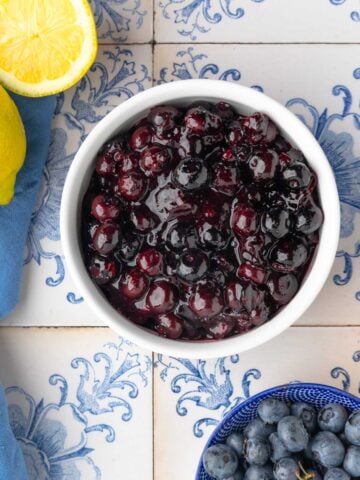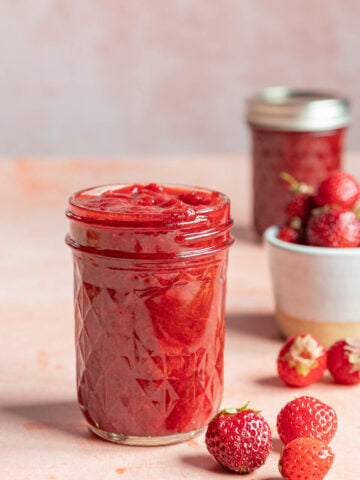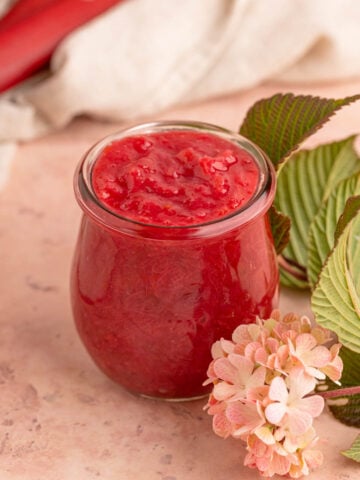Fresh apricots are the star of this creamy, tangy Apricot Curd recipe. The technique for this fruit curd is based on my strawberry curd recipe. The recipe starts with making an apricot puree to get the most flavor possible from the fruit. Made with just 5 ingredients, this recipe requires only 30 minutes of hands-on time before the curd is chilled and ready to eat. To ensure your success at this recipe I've provided you with step-by-step instructions.

Jump to:
About This Apricot Curd Recipe
After citrus fruit (lemons, limes, and oranges) I think apricots are one of the best fruits to use for a fruit curd. With their naturally sweet-tart flavor, they make a curd that is a delicious balance of both.
When I made this curd the first time, I couldn't stop eating it by the spoonful, it was surprisingly so good. Believe me when I say you may end up taste-testing half the batch the first time you make it.
This recipe really is easy to make. The flavor is fantastic - tart, sweet, creamy and bursting with apricot flavor. Like most of my curd recipes, this recipe makes 2 cups, enough to fill a tart shell or use as a generous topping for pancakes.
My love of fruit curds started with lemon curd and now they're one of my favorite things to make. For more homemade curd ideas, check out my other fruit curd recipes on the blog. There are 16 to choose from. Some of my favorites include:
Apricot Curd Ingredients
You'll need the following ingredients for this creamy, tart, and fruity apricot curd:
- Fresh Apricots: This curd tastes best when made with fresh apricots. Taste the apricots before you start making the curd. They should have a sweet-tart flavor and a peach's texture.
- Granulated Sugar: Sugar adds sweetness, but the main purpose of the sugar is to combine with the eggs to create a creamy custard. The sugar breaks up the protein clumps in the eggs, which results in raising the temperature in which the eggs set. Permitting the egg proteins to set slow and disperse with the other ingredients results in a smooth and creamy apricot curd.
- Fresh Lemon Juice: The lemon juice adds a little tartness to the curd and complements the apricot flavor.
- Large Egg Yolks: The eggs add flavor, thicken the curd, and create a creamy texture. They also make a stable emulsion - meaning the curd won't separate or break apart when it cools
- Unsalted Butter: Butter adds richness to the curd and helps make the curd satiny smooth. If you are allergic to dairy you can make the curd without butter. It will be a little less creamy, but still taste delicious.

Full ingredients, measurements, and instructions are in the recipe card at the bottom of this post.
How to Make Apricot Curd
To make the best possible apricot curd, we start by making a puree, which will be thick and get thicker as we cook it with the eggs and add the butter. Yum!
Step 1: Separate the egg yolks into a glass container. Store the leftover egg whites in the refrigerator in an airtight glass container.

Step 2: Place the sliced apricots, lemon juice, and the sugar in the saucepan

Step 3: Cook the apricots until they are soft enough to press flat with the back of a spoon

Step 4: Puree the Apricots until they are smooth. Let the mixture cool to about 80-85°F degrees.

Step 5: Add the eggs and cook the curd until it reaches 185°F and it coats the back of a spoon.
A nonreactive pan is a pan that doesn't react with the food being cooked. Stainless steel and enamel-coated cast iron are non-reactive, and aluminum and cast iron are reactive. Reactive pans will react with the acid in the juice and change the flavor of the final dish.
Step 6: Place the saucepan over medium-low heat and whisk constantly. Make sure to cover the entire bottom of the pan while whisking.
Don't walk away from the curd while it's cooking or it will burn. If you have to walk away, remove the pan from the heat.
As the curd starts to thicken and steam rises from the surface, check the temperature often using an instant-read thermometer. Cook the curd until it reaches a temperature of 180°F or it coats the back of a spoon and doesn't run off. I recommend using the thermometer for the best results.
Don't let the curd boil. Boiling curd will cause it to curdle and create a grainy texture. If the apricot curd curdles, strain it twice through a fine-mesh strainer, to remove the grainy bits. If that doesn't work, process it in a blender to try and smooth it out.

Step 9: Cover the apricot curd with plastic wrap to keep a skin from forming on top of the curd.
Chill the curd immediately to keep bacteria from forming.
How to Store the Curd
- Refrigerate: Refrigerate the curd in an airtight container for up to 2 weeks.
- Freezer: Place the apricot curd in an airtight freezer-safe container for up to one (1) year. When ready to use the curd, let it thaw in the refrigerator for 24 hours before using it.

What To Do With Apricot Curd
There are many different ways to use apricot curd.
- Combine it with fresh blueberries and little whipped cream for a delicious no-bake dessert.
- Make crepes, and fill them with this creamy apricot curd topped with fresh whipped cream
- For a quick and impressive dessert use it as an ice cream topping or cheesecake.
Pro Tips for Success
- Use a non-reactive saucepan, like stainless steel or enamel-coated cast iron. Avoid aluminum, which can give the curd a metallic taste.
- Check the temperature often with an instant-read thermometer, and don't let the curd boil. Boiling can cause the curd to curdle and become grainy.
- Cover the surface of the curd with plastic wrap to prevent a skin from forming on top of the curd.
- Chill the curd immediately to prevent bacteria from forming.

If you make this apricot curd please leave a rating and a comment below.
Connect with me on Instagram and tag me @bakesbybrownsugar to share your recipe remake photos.
Like what you see? Click here to subscribe to Bake's by Brown Sugar Baking Newsletter to get free and delicious treats delivered to your inbox.
If You Like This Recipe, Try These Other Fruit Curd Recipes
Want to Save This Recipe?
Enter your email below and I'll send it to your inbox. Plus get new and recommended recipes sent to you every week!
By submitting this form, you consent to receive emails from Bakes by Brown Sugar.

Apricot Curd with Fresh Apricots
Ingredients
- 1-1/4 pound (568 grams) fresh apricots
- 1/2 cup (100 grams) granulated sugar
- 2 tablespoons lemon juice
- 4 large (80 grams) egg yolks
- 1/8 teaspoon kosher salt
- 1/2 teaspoon pure vanilla extract
- 4 tablespoons (57 grams) unsalted butter room temperature
Instructions
- Remove the pit from the apricots and cut each half into 4 slices (wedges). Place them in a large saucepan, along with the sugar and lemon juice. Stir the ingredients together and let the apricots macerate for 30 minutes. After 30 minutes the sugar should have started to dissolve, and some liquid should have been released from the apricots.
- Cook the apricots on high heat until the liquid just begins to boil. Immediately reduce the heat to medium and cook until the fruit is soft and has started to break down into small soft pieces. The apricot should be soft enough to easily mash with the back of a large spoon.
- Remove the pan from the heat and let it cool for 5 minutes. Puree the apricots using a stick blender until they are smooth. You should have about 1-1/2 cups of thick puree. Taste the puree and add additional sugar to taste, but no more than 3-4 tablespoons. The final curd should be tart and hit the back of the throat with its tartness.
- Let the puree cool to about 85°F (30°F). Place a bowl with a fine mesh strainer next to the stove.
- Add the egg yolks to the puree and whisk until the eggs are fully incorporated. Return the pan to the stove and cook over medium heat until the curd has thickened and reached a temperature of 180°F (82°C). Use an instant read thermometer to check the temperature. Do not let the curd boil, that will lead to curdled eggs. The curd will also be thick enough to coat the back of a spoon and leave a trail when you run your finger through it.
- Remove the pan from the heat and stir in the vanilla extract. Whisk in the butter 1 tablespoon at a time. Pour the curd into the strainer and use the back of a large spoon or a spatula to press the curd through the strainer.
- Cover the surface of the curd with plastic wrap and chill the curd immediately to prevent bacteria from forming for 3 hours. The curd should be smooth, creamy, and hold its shape when scooped with a spoon.
How to Store Apricot Curd
- Refrigerator: This curd is good in the refrigerator up to 2 weeks in an airtight container.
- Freezer: The curd can be frozen for up to 1 year in a freezer-safe container. Place the curd in the container and leave about 1/2-inch from the top of the container
- When ready to use the curd, thaw it in the refrigerator for 24 hours.










Hillmann says
Where is the butter?
Cheryl Norris says
Hi Hillmann
The butter is whisked into the curd after the curd is cooked. See step 6.
Karla says
This is so good!!
Might be one of my favorite flavors!
Cheryl Norris says
Hi Karla
Thank you for trying this apricot. I'm so glad you liked it. I like that tart-sweet flavor you get with the apricots.
Janet S. says
Prepared this recipe exactly as written. Did not add additional sugar. Easy and delicious! Will keep this to use into the future as my daughter and family have a very prolific apricot tree. Now I want one for myself!
Cheryl Norris says
Hi Janet
I want an apricot tree too!😁. Thank you for trying this recipe and leaving this review. I'm so glad you enjoyed it.